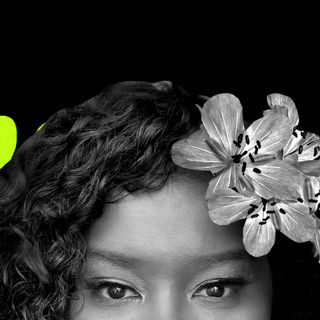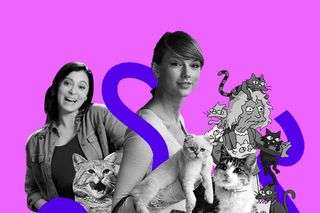
The Return of the ‘Crazy Cat Lady’ Has Nothing to Do With Cats
The mockery and pity is an attempt at parading the fate of these women as a cautionary tale, rather than the active choice it can be.

Welcoming her third cat, Benjamin Button, in 2019, Taylor Swift affirmed her status as the infamous cat lady. But there was a divergence — this cat lady had a fulfilling relationship with her partner, and so, she wasn’t “alone.” With the news of her recent breakup sending fans into a frenzy, though, dissecting the stereotype and its derisive association with unhinged behavior and loneliness, has once again become pertinent. Especially so, since the decade of the 2020s, too, has witnessed the resurgence of the cat lady in pop culture — often, through female characters who are simply content on their own terms. In fact, the aura of the “crazy cat lady” doesn’t require the presence of cats at all anymore: think Dr. Jean Milburn from Sex Education, the titular characters in Grace and Frankie, and even the general vibe of the characters portrayed by Jennifer Coolidge across shows like The White Lotus and movies like Like A Boss.
The trope first emerged in pop culture at the turn of the 21st century, as a sort of post-modern twist to the existent spinster cliché. Culture has time and again found a way to characterize women with undertones of rage and idiosyncrasies as unstable — be it through diagnosing them with hysteria, burning them at stake following witch hunts, and even desexualizing them — all in a bid to push them towards a heteronormative agenda that values women only in terms of their youthfulness, their relationship status, and their wombs.
Pop culture has forever been a site of feminist struggle, too, and thus emerges the need to see the crazy cat lady for who she really is; she isn’t a comic relief, a denigration, or a shorthand for loneliness. Instead, she represents a version of femininity that refuses the co-dependency that forms a basis for heterosexual attraction. The Simpsons went on to become one of the first contemporary shows to ground and encourage the genesis of the crazy cat lady through the character of Eleanor Abernathy — more easily recognized by an endless supply of felines and alcohol. Although a flawed character, Abernathy represented an archetypal tragedy in pop culture — one of a single, educated, and established single woman transforming into a resident crazy cat lady and thus witnessing the downfall of her personal and professional life. This sparked debates that became foundational arguments for postfeminism. Although used as a recurring gag, her character arc represented the very real consequences of burnout, loneliness, and gender norms.
Interestingly, even though cat ladies have been personified as unloveable, sad, and sexless women who forgo romantic and familial love, for their felines, the cultural pejorative attached to this term has no bone to pick with cats. Instead, by criticizing women for choosing to free themselves from the claws of patriarchy, and opting for those of cats instead, society attempts to allay its anxieties around women being defined by anything other than their domesticity. And so, rather than being a representation of failed womanhood, she represents women who willingly transgress social norms. In doing so, it reflects reality too: an article in The Guardian cites a survey from 2019 that shows how the number of women, who never married, and don’t live with partners, is rising in every age range under 70.
Related on The Swaddle:
How Shaming Women for Their Choices Breeds Lifelong Self‑Doubt
But that’s the truth society wants to twist — parading the fate of these women as a cautionary tale, rather than an active choice. The latter would invariably be in conflict with the notion that women’s worth is defined in terms of their submissiveness and desirability to men. The idea that women can have fulfilling lives beyond the heteronormative convention that’s been imposed on them is what fuels the stereotype of the crazy cat lady. The disdain, mockery, and pity it attracts are, then, meant to draw attention away from the freedom that the stereotype could otherwise come to represent. The stereotype of a crazy cat lady, in that sense, is simply a case of “grapes are sour.”
But pop culture has convinced us that the cat lady is not an outcome one must desire, but is rather an inevitability one must strive to avoid at all costs; even an unhappy married life is supposed to give you more pleasure than one that’s led in isolation. However, there is no such equivalent for men with cats. They are rather considered more dateable, and definitely not deranged.
A musical number from the show Crazy Ex-Girlfriend, satirically manifests our worst fears of being alone forever, saying, “I walk myself down to the ‘Lonely Lady Cat Store,’ the smell is overwhelming inside. This is the future smell of my house, it is the smell of my dreams that have died.” Amid the humor, there is a subliminal undertone that allows us to sympathize with the eponymous female lead. Eventually, when the show ends with her choosing to pursue her dream of being part of musical theaters, rather than being involved in relationships that might set her back again, it forces us to question the social conditioning to find love and prioritize it above all else.
It is indeed baffling when put into perspective how women are pushed towards dependency and unhappiness, simply to fit a mold. In a way, women and cats are quite similar in the way they have been (mis)treated and abandoned by society — both have a long history of being linked with heresy and have been vilified for their non-conformity and disobedience in adherence to the cultural order. If women who refuse to bow down to the patriarchy were deemed witches, then cats were perceived as their agents. But it’s time to reclaim the association of the woman and the cat by restoring the tarnished identity of the cat lady and celebrating her — rather than making her a subject of pity and mockery.
Hetvi is an enthusiast of pop culture and all things literary. Her writing is at the convergence of gender, economics, technology and cultural criticism. You can find her at @hetviii.k.
Related


The Virginity Hamper: Products For Society’s Virginity Needs
